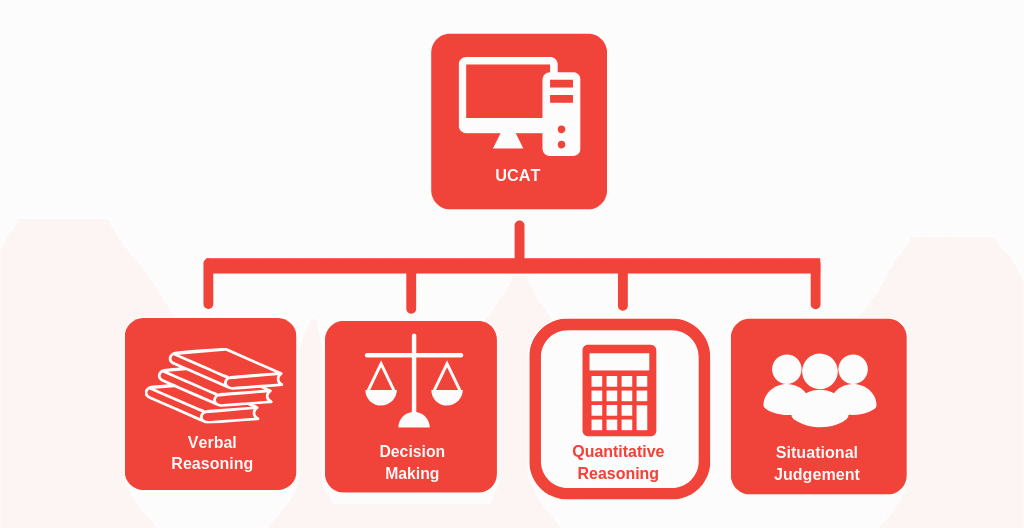How To Prepare For UCAT Quantitative Reasoning
In this section, we will cover what UCAT Quantitative Reasoning entails, and how to effectively answer UCAT Quantitative Reasoning questions.
What is UCAT Quantitative Reasoning?
Quantitative Reasoning is the third subtest in the UCAT.
It assesses your numerical and problem solving abilities. Note that it is not just a ‘maths test’, but rather a reasoning test requiring you to use mathematical skills.

Why is Quantitative Reasoning important in medicine?
Doctors will often need to make calculations in their day to day work, for example, when calculating medication doses and in research. They often need to make calculations quickly, and use them as a basis to make decisions and solve problems.
What is the structure of UCAT Quantitative Reasoning?

In this UCAT subtest, you will have 36 questions to answer in 26 minutes, which is an average of 43 seconds per question. Most UCAT Quantitative Reasoning questions are presented in units of four questions, however, some questions are ‘standalone’ or individual.
In UCAT Quantitative Reasoning, you will be presented with text and/or tables, graphs or diagrams that you will need to interpret. You will then need to select the correct answer from among the available five options. The difficulty of questions varies from straightforward to more complex. You will often need to make multiple calculations to arrive at the correct answer, and avoid common wrong answer ‘traps’.
What are the types of UCAT Quantitative Reasoning question?
UCAT Quantitative Reasoning questions cover a range of numerical abilities. These include:

Percentages: Calculating percentage increase or decrease in prices of quantities of an item. You may be required to convert between percentages, decimals, fractions and ratios.
|
Example Question - Percentages Click Here For Solutions |
|||||||||||||||||||||||||
|---|---|---|---|---|---|---|---|---|---|---|---|---|---|---|---|---|---|---|---|---|---|---|---|---|---|
Quantitative Reasoning Question 12Stimulus A television streaming service changes its fees from last year to this year. The following represents the original and new fees (in $ per month) for it’s basic, premium and ultimate packages, as well as showing the number of customers paying for each of these packages.
Note: The service can only be purchased/switched to a different package at the beginning of a month. Question The company decide to raise their prices by the following from this year to the next year: 10% increase for basic package, 7% decrease for premium package and 15% increase for ultimate package. If the amount of customers for each package remains the same as this year, what is the percentage change in income from last year to next year?
|
|||||||||||||||||||||||||
Proportionality: Calculating direct and indirect proportions and converting between units.
|
Example Question - Proportionality Click Here For Solutions |
|---|
Quantitative Reasoning Question 4Stimulus The chart below shows the results of a traffic survey conducted this year. The numbers in each bar show the actual number of vehicles of each colour counted. These are all the types of vehicles considered. 
A large motor reseller (which sells vans/minibuses and buses/coaches) uses these statistics to work out how many vehicles they should preorder for resale in their yard, and in what colours in a given year. The reseller preorders vehicles in the same proportions as these statistics. Question Based on this survey, they have purchased 377 white vans/minbuses. How many blue buses/coaches will they pre-order?
|
Rates: Calculating the speed of an object, or rates of flow.
Averages: Calculating the mean, mode or median from data presented, including use of combined samples and use in prediction.
Other: Other skills required in UCAT Quantitative Reasoning include an understanding of ratios, geometry and data interpretation.
What strategies can I use to answer UCAT Quantitative Reasoning questions?
To do well in UCAT Quantitative Reasoning, it is important to look for shortcuts and develop your mental maths skills. Although you are provided with a calculator in UCAT, it is often much quicker to make calculations ‘in your head’ or on your UCAT notebook. Over-use of a calculator will usually lead to you running out of time to answer the questions. It is also important to have a solid understanding of various mathematical principles, including percentage change, rates, averages, ratios and geometry. There are many other strategies that can be used to answer UCAT Quantitative Reasoning questions quickly and accurately, which are covered in detail in MedEntry UCAT Courses.
How should I prepare for UCAT Quantitative Reasoning?
You can assess your ability in UCAT Quantitative Reasoning with MedEntry’s free Diagnostic Test. You should develop effective strategies to answer UCAT Quantitative Reasoning questions by attending a UCAT Workshop and using MedEntry’s comprehensive guided curriculum. Practice the strategies by working on the UCAT practice exams, subtest mocks and drills on MedEntry’s UCAT online platform. Use MedEntry’s sophisticated feedback and personalised adaptive learning technology to target your weak areas in the lead up to UCAT test day.